Why Scheduling Breaks at Work is Important for Heat Stress Prevention - Toolbox Talks
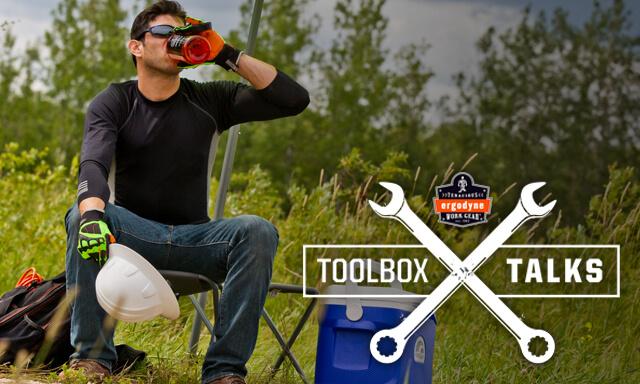
In 2014, OSHA kicked off an annual campaign to train and educate workers about heat stress management called Water. Rest. Shade. Share this Toolbox Talk PDF (Topic: Rest) with your crew to educate them on the importance of taking regular breaks while working in the heat.
Take a load off... even if your name isn’t Annie. Especially when it comes to working in the heat. Heat-related illnesses can progress from mild (heat cramps) to severe (heat stress) to deadly (heat stroke), which is why it’s so important to know the signs and symptoms, use smart work/rest scheduling and push critically important rest breaks, water and shade.
GETTING USED TO THE HEAT
Heat impacts each individual differently based on a number of factors like age, physical fitness, medications, amount of PPE they’re wearing and how well they’re acclimated to the heat—just to name a few. And some health conditions can put workers at greater risk of heat-related illness, such as diabetes, kidney and heart problems, pregnancy or being overweight). Heat acclimatization plays a large part in how the body is able to respond to and cope with heat exposure. Acclimatization is important especially for both new workers and those working during heat waves.
According to the Korey Stringer Institute at the University of Connecticut, heat acclimatization is a complex series of changes or adaptations in the body that occur in response to heat stress over the course of 7 to 14 days (peaking after 14 days of exposure). Acclimatization allows the body to better cope with heat stress and can beneficially reduce heart rate, lower body/skin temperature responses to heat and reduce perceived exertion. It can also increase sweating, sweating onset (meaning it starts earlier to cool the body), heart function/blood distribution and overall ability to perform in the heat. All of this is to say that a worker who is properly acclimated to the heat will perform better and their body will be less stressed in the heat than someone who has not been acclimated. However, no one is immune to heat-related illnesses if proper water, rest and shade practices aren’t being followed. Acclimatization is a means to help reduce the risk of heat stress, not completely eliminate it.
HOW TO ACCLIMATIZE TO THE HEAT
Over time, workers can gradually acclimatize themselves to the heat. This can happen naturally as temperatures climb during the warmer months or—in the case of a sudden heatwave—it can happen over days with careful planning and balancing of work and rest periods. Full acclimatization usually takes up to 14 days of exposure to hot conditions. Acclimatization is necessary for new workers and those who have been out sick or on extended absence of a week or more.
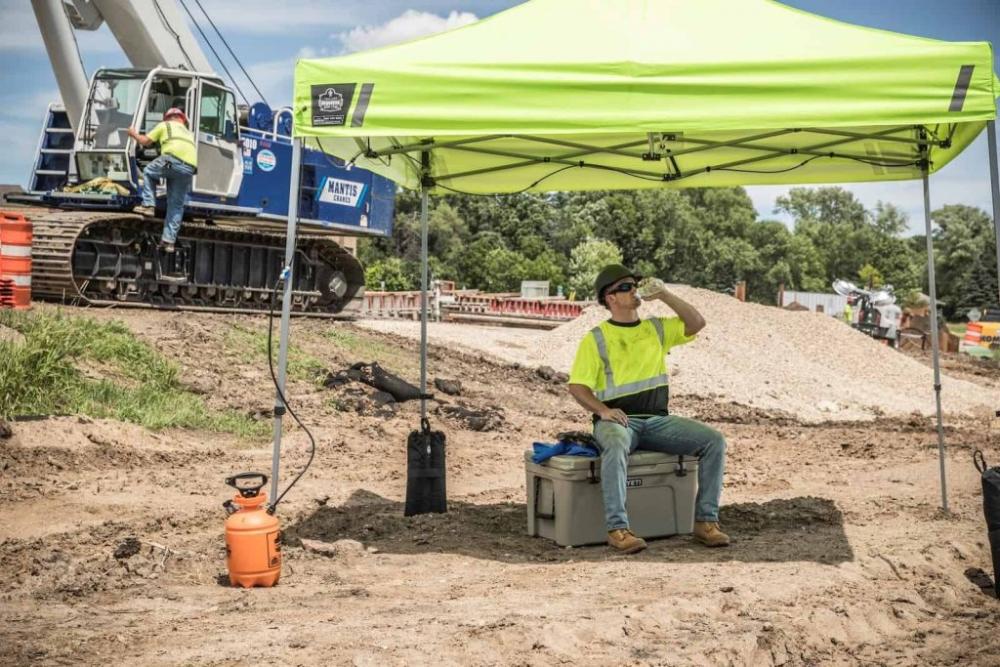
On the first day of work in a hot environment, the body has to work much harder to cool itself. Body temperature, pulse rate and general discomfort are higher on day one but, with each day following, these responses will gradually decrease while sweat rate increases—allowing the body to better handle the heat. Overall, more frequent and shorter periods of heat exposure are better than fewer, longer exposures. Therefore, new workers or those returning from an absence should be monitored closely for signs of heat distress during the first few days of working in the heat. According to OSHA, workers should start with 20% of their normal workload (or about an hour and a half of an 8-hour shift) in the heat on day 1, increasing incrementally by no more than 20% each subsequent day.
A hot-weather example schedule for a new worker would be:
-
Day 1: 20% workload, or 1.5 hours of 8 hours
-
Day 2: 40% workload, or 3 of 8 hours
-
Day 3: 60% workload, 5 of 8 hours
-
Day 4: 80% workload, 6 of 8 hours
-
Day 5: 100% workload, full 8-hour shift
In the event of a heatwave, acclimatization activities should happen for all workers and the following work/rest balance should be followed until they’re acclimated:
-
Day 1: 50% workload, or 4 of 8 hours
-
Day 2: 60% workload, 5 of 8 hours
-
Day 3: 80% workload, 6.5 of 8 hours
-
Day 4: 100% workload, full 8-hour shift
These lightened workloads don’t necessarily mean workers are taking a nap in the shade for half of their first day in the heat. Rest can be light duty like attending training, sorting parts or filling out paperwork in a shaded or air-conditioned area. Ensure that the rest area is blocked from the sun and that water or sports drinks are easily available.
THE IMPORTANCE OF BREAKS
Heat stress is a real danger to crews working in the heat. Heat stress is when the body’s ability to control its internal temperature begins to fail. Body temps rise above 99.7° F (37.6° C) and the body begins to sweat profusely. If the body isn’t allowed to cool down and body temperature reaches 104° F (40° C), severe heat-related illness can occur. Symptoms of heat stress include headache, excessive sweating, dizziness, heat cramps, confusion and more (all of which are detailed in our Guide to Heat Stress Risks & Solutions). Allowing workers to take a break in the shade and rehydrate gives their bodies a chance to cool down, shed excess heat and regulate their internal core temperature.
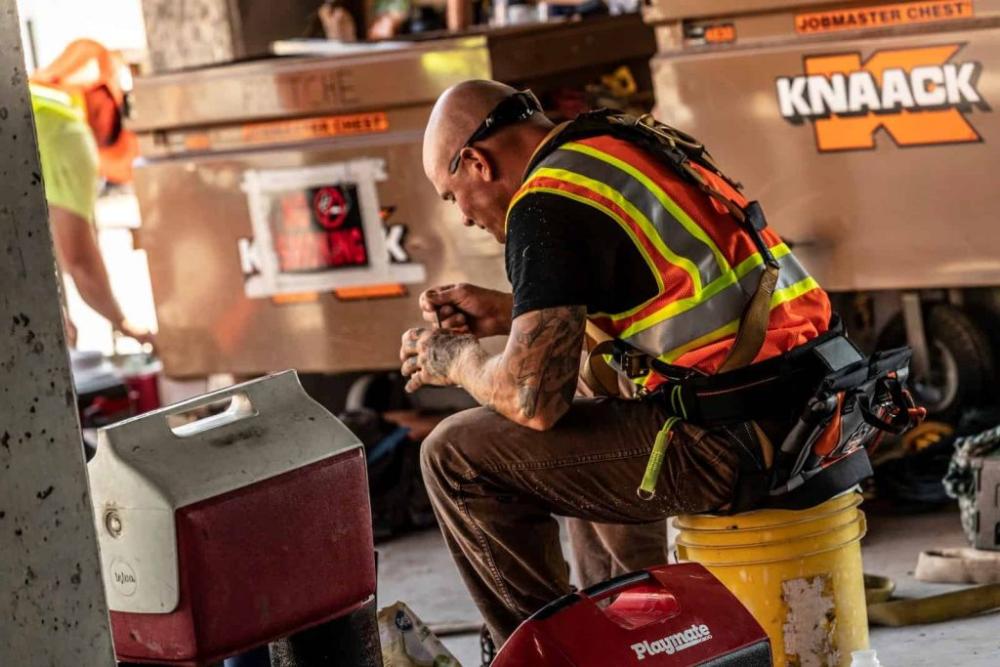
Periodic rest breaks are more effective at keeping the body cool than taking a break when a worker feels too hot. Think prevention, rather than fixing something that’s wrong. Workers that wait until symptoms appear to finally take a cool-down break are at risk for developing a serious heat-related illness—and the progression to a serious illness can be rapid once symptoms begin.
According to a California statute, “Employees shall be allowed and encouraged to take a preventative cool-down rest in the shade for a period of no less than five minutes at a time when they feel the need to do so to protect themselves from overheating.” These preventative breaks are not the same as regularly scheduled rest breaks like meal times. These breaks should not be rushed, especially if the worker is feeling like they may be overheated. During a cool-down rest, workers should be monitored for signs of heat stress and have access to drinking water. If any signs of heat illness are observed or reported, the employer must not order the worker back to work and the worker must be observed and monitored until symptoms have abated. If heat illness is suspected or reported, first aid procedures should be started immediately. Any workers with symptoms of heat-related illness should not be left alone or sent home without being offered onsite first aid or medical attention, depending on severity.
SCHEDULING REST PERIODS
Setting the right working hours and breaks schedules for workers in the heat is critical. The chart below details work/rest schedules, plus water intake for both unacclimated and acclimated workers. Use this as a guide and adjust as the weather dictates. A supervisor on your staff should be actively enforcing these break times, and ensuring the break area provides shade and easy access to water.
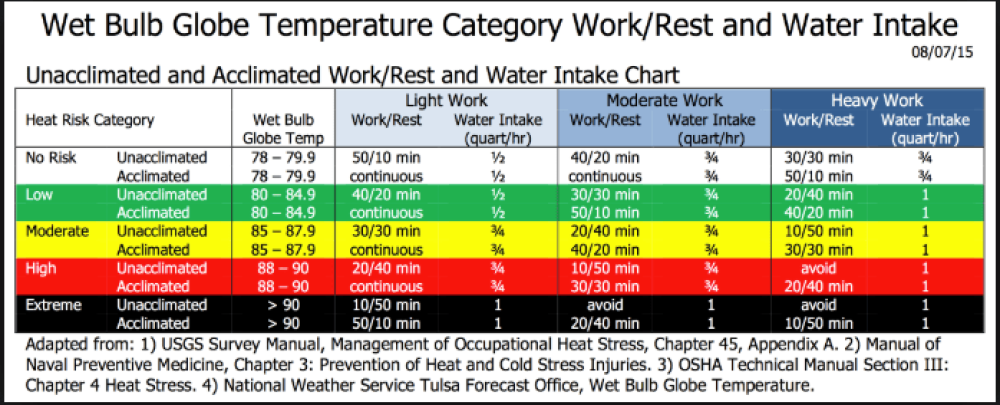
As always, be mindful of what the weather is doing. Work/rest periods may need to be adjusted further when conditions change. Shorten work periods and increase rest times:
-
As temperature rises
-
As humidity increases
-
As the sun gets stronger
-
When there is little to no air movement
-
If heavy protective gear is being worn
Understanding that not all workers react to the heat in the same way or that some workers are responsible for more strenuous activities, work/rest times may need to be individually adjusted. The chart below goes into more detail of work/rest scheduling based on temperature and the level of intensity of the work.
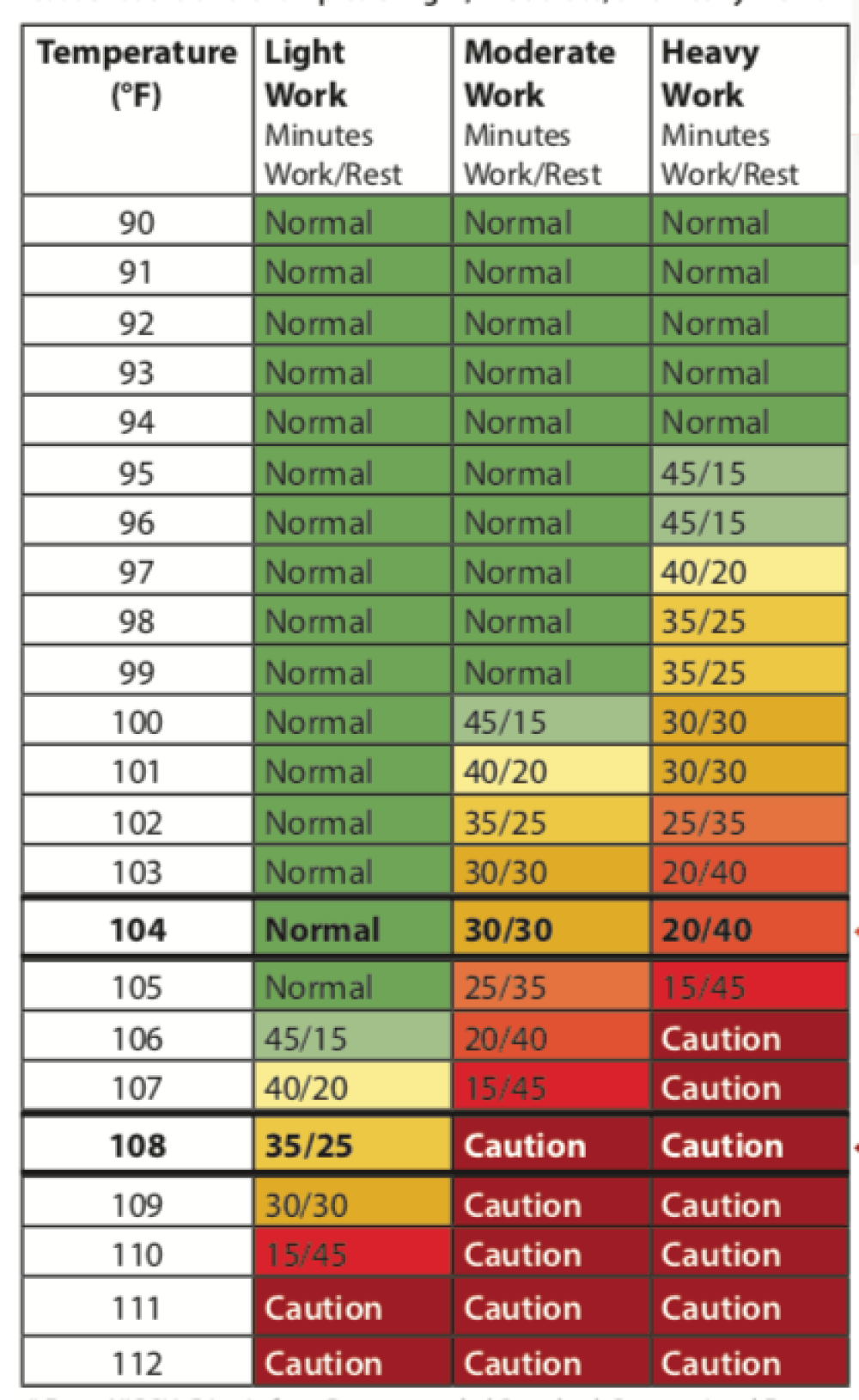
You can also make adjustments to the workload to help minimize risk. Steps include:
-
Scheduling heavy tasks to earlier in the day when it’s cooler
-
Set up shade canopies in various stations at the jobsite
-
Allow only acclimatized workers to perform the more strenuous tasks
-
Rotate demanding jobs among acclimatized workers
-
Add extra workers to heavy jobs to spread out the workload
-
Decrease the physical demands or pace of the job, increase amount of rest time or allow a slower pace
-
Provide workers with personal cooling equipment (cooling vests, dampened towels, cooling bandanas or sleeves, misting stations)
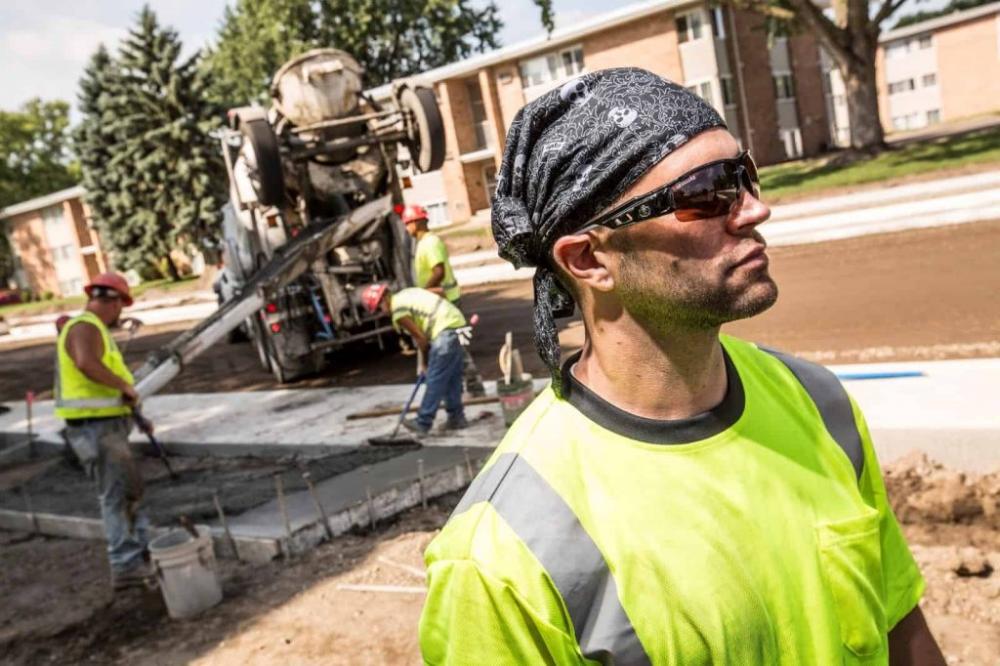
By adopting smart scheduling techniques and ensuring workers are taking the time to rest, you can ward off dangerous heat-related illnesses in your crew. Remember, heat-related illnesses are 100% preventable. With a few changes to workload and schedules, you and your crew can accomplish more in the heat. So go ahead, take a load off.


